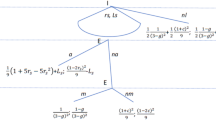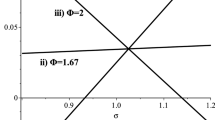Abstract
This paper extends the pure theory of patents to make it consistent with the empirical evidence on R&D which shows both variable returns to scale and a variable elasticity of cost reduction with respect to R&D (output elasticity). Using a generalized invention possibility function, the authors show that for a given social rate of discount, a socially optimal patent depends only on output elasticity and demand elasticity. The authors also show that an optimal patent can exist for increasing returns as well as for constant and decreasing returns to R&D. In general, the constant elasticity assumption overestimates the optimal life of a patent.
Similar content being viewed by others
References
Angilley, A. S. “Returns to Scale in Research in the Ethical Pharmaceutical Industry: Some Further Empirical Evidence,”Journal of Industrial Economics, 22, 2, December 1973, pp. 81–93.
Berkowitz, M. K.; Kotowitz, Y. “Optimal Patent Design with Free Entry in the Invention Market,” University of Toronto, Institute for Policy Analysis, Working Paper No. 7921, 1979.
__. “Patent Policy in an Open Economy,”Canadian Journal of Economics, 15, 1, February 1982, pp. 1–17.
Comanor, W. S. “Research and Technical Change in the Pharmaceutical Industry,”Review of Economic Statistics, 47, 2, May 1965, pp. 182–90.
Dasgupta, P.; Stiglitz, J. “Industrial Structure and the Nature of Economic Activity,”Economic Journal, 90, June 1980, pp. 263–93.
Friedman, Murray N. The Research and Development Factor in Mergers and Acquisitions, Study No. 16, U.S. Congress, Senate Committee on the Judiciary, Subcommittee on Patents, Trademarks, and Copyrights, 85th Congress, 2nd Session, 1958.
Griliches, A. “Returns to Research and Development Expenditures in the Private Sector,” in J. W. Kendrick and B. Vaccara, eds.,New Developments in Productivity Measurement and Analysis, Chicago: University of Chicago Press, 1980.
Kamien, Morton I.; Schwartze, Nancy L. “Market Structure and Innovation: A Survey,”Journal of Economic Literature, 13, March 1975, pp. 1–37.
Kitti, Carole. “Patent Policy and the Optimal Timing of Innovations,” Unpublished Ph.D. dissertation, University of Chicago, 1973.
Kohn, M.; Scott, J. T. “Scale Economies in Research and Development: The Schumpeterian Hypothesis,”Journal of Industrial Economics, 10, 3, 1982, pp. 239–49.
Kuznets, S. S.Secular Movements in Production and Prices, Boston: Houghton Mifflin, 1930.
Mansfield, E. “Rates of Return from Industrial Research and Development,”American Economic Review, 55, May 1965, pp. 310–22.
__Industrial Research and Technological Innovation, New York: W. W. Norton, 1968.
__ “Social and Private Rates of Return from Industrial Innovations,”Quarterly Journal of Economics, 91, May 1977, pp. 221–40.
McFetridge, Donald G.; Rafiquzzaman, R. “The Scope and Duration of the of the Patent Right and the Nature of Research Rivalry,” paper presented to the Economic Analysis of Intellectual Property Rights Conference, University of Western Ontario, London, Ontario, April 1983.
Minasian, J. R. “The Economics of Research and Development,” in R. Nelson, ed.,The Rate and Direction of Inventive Activity, Princeton: Princeton University Press, 1962, pp. 93–141.
__ “Research and Development Production Functions and Rates of Return,”American Economic Review, 59, May 1969, pp. 80–5.
Nordhaus, William D.Invention, Growth, and Welfare, Cambridge, MA: M.I.T. Press, 1969.
Scherer, F. M. “Nordhaus' Theory of Optimal Patent Life: A Geometric Reinterpretation,”American Economic Review, 62, June 1972, pp. 422–31.
__Industrial Market Structure and Economic Performance, 2nd ed., Chicago: Rand and McNally, 1980.
__ “The Propensity to Patent,”International Journal of Industrial Organization, 1, 1983, pp. 107–28.
Schmookler, Jacob.Invention and Eeconomic Growth, Cambridge, MA: Harvard University Press, 1967.
Stigler, G. J.The Organization of Industry, Homewood: Irwin, 1968.
Tandon, P. “Optimal Patents with Compulsory Licensing,”Journal of Political Economy, 90, 3, 1982, pp. 470–86.
Terleckyj, N.Effects of R&D on the Productivity Growth of Industries, An Exploratory Study, Washington D.C.: Natural Planning Association, 1974.
Author information
Authors and Affiliations
Rights and permissions
About this article
Cite this article
Dore, M.H.I., Kushner, J. & Masse, I. The optimal length of a patent with variable output elasticity and returns to scale in R&D. Atlantic Economic Journal 21, 10–26 (1993). https://doi.org/10.1007/BF02299772
Issue Date:
DOI: https://doi.org/10.1007/BF02299772




